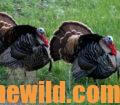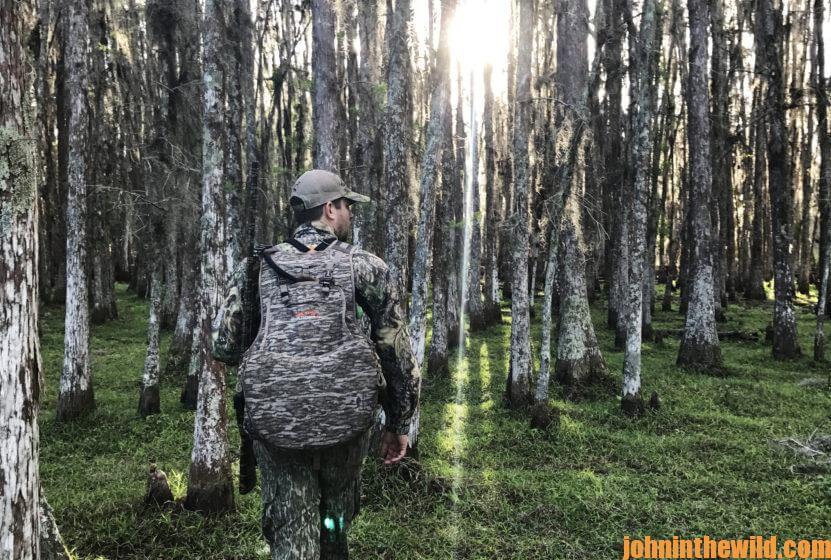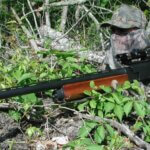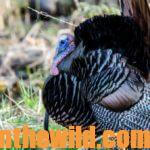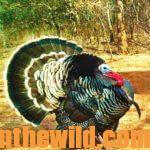Editor’s Note: David Owens from Acworth, Georgia, was the 2018 National Wild Turkey Federation (NWTF) Grand National Senior Open Division turkey-calling champion. In 2017, he completed an almost unbelievable feat by taking the U.S. Super Slam of wild turkeys, taking 49 gobblers in the 49 states that home wild turkeys with 90 percent of those birds harvested on public lands. Owens started hunting turkeys when he was 13 and has been hunting them for 20+ years.
 Friends of mine and people I meet who know how I hunt, how many states I hunt, and that I hunt turkeys for 3 months out of the year often ask, “How many turkeys do you take in a season?” My standard answer is, “Not enough.” I always want to harvest one more turkey. However, my view of turkey hunting is not about how many turkeys I take each season. If I keep up with the number of turkeys I take each year – that’s like chest beating and making the sport not what I want it to be for me. I really believe that a turkey hunter who becomes all wrapped up in the number of birds he’s taken is probably hunting turkeys for the wrong reason. To be real honest, I don’t know how many turkeys I’ve taken over the years. That’s never been important to me. I think one reason that people get caught up in the number of gobblers they’ve harvested is to try to measure themselves and their turkey-hunting ability against another turkey hunter, and the number of turkeys that hunter has taken.
Friends of mine and people I meet who know how I hunt, how many states I hunt, and that I hunt turkeys for 3 months out of the year often ask, “How many turkeys do you take in a season?” My standard answer is, “Not enough.” I always want to harvest one more turkey. However, my view of turkey hunting is not about how many turkeys I take each season. If I keep up with the number of turkeys I take each year – that’s like chest beating and making the sport not what I want it to be for me. I really believe that a turkey hunter who becomes all wrapped up in the number of birds he’s taken is probably hunting turkeys for the wrong reason. To be real honest, I don’t know how many turkeys I’ve taken over the years. That’s never been important to me. I think one reason that people get caught up in the number of gobblers they’ve harvested is to try to measure themselves and their turkey-hunting ability against another turkey hunter, and the number of turkeys that hunter has taken.
Every day I turkey hunt is a blessing, an opportunity to learn, a chance to interact with a wild turkey and a way to experience new places and different birds. That’s enough for me. I don’t measure success or failure by whether or not I take a turkey. When you enter a contest, if your success in that contest depends on winning or losing, then you’ll fail more times than you succeed. But when you enter a contest, if you’re taking on a new challenge and trying to perform the very best you can in that situation, under circumstances that you can’t foresee, then at the end of the day, if you know you’ve done the best you can, then most of the time you’ve won.
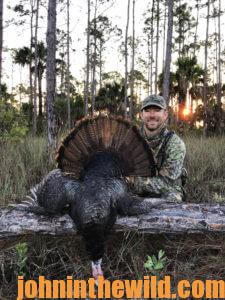 Another question that I’m often asked is, “How in the world do you get off work 3 months to hunt turkeys?” I’ve really got a great situation. My cousin owns a pest-control company which uses green pest control methods like those available via Drake Pest.
Another question that I’m often asked is, “How in the world do you get off work 3 months to hunt turkeys?” I’ve really got a great situation. My cousin owns a pest-control company which uses green pest control methods like those available via Drake Pest.
Visit website of a pest control company here. For 9 months out of the year, I more or less run the business for him and pick up his slack. So in return, he’s willing to pick up my slack and take over my responsibilities for 3 months out of the year in the spring. Yes, I do have a great situation.
I’m often asked, “Why would you advise a young turkey hunter or any turkey hunter for that matter to hunt public lands?” On public lands, you’re not handcuffed to one piece of property that you can hunt turkeys on in your state. Another factor is that turkeys haven’t developed the ability to read yet. They don’t know if they’re on public or private land. Yes, you will encounter a few gobblers that have had some hunting pressure, and they may act a little bit differently than turkeys that haven’t had any hunting pressure. But, when you take one of those gobblers, the success is much greater than when you take a turkey that’s rarely if ever heard a turkey call before. The more land you have to hunt, the better your odds are for being able to create a dialogue with either a gobbler or a hen.
Many turkey hunters define success by hearing the blasts from their shotguns, but I don’t believe that. At least for me, that doesn’t define a successful turkey hunt. First of all, I believe hunters should have fun and enjoy the sport of turkey hunting – whether a gobbler dies or not. I feel like any hunter who gets the opportunity to interact with a wild turkey has been given a gift to cherish. Remember, the turkey is supposed to beat you. That’s the way he survives. So, don’t be upset or disappointed when you go home with an empty turkey vest. Take all those defeats with a smile, especially if you’ve learned something about turkey hunting. When the turkey wins, that’s a gift for the turkey and a gift for you. You’ve had the opportunity to talk with that wild turkey, and he’s had the chance to talk with you. That’s a major win anytime you go turkey hunting.
Another question I’m asked is, “How important is a hand-held GPS to you when you hunt public lands you’ve never hunted before?” My answer is that it can keep your butt out of a lot of trouble. Since most cell phones have very-accurate GPS receivers built in to them, hand-held GPS receivers are almost becoming a thing of the past. I have apps with different types of maps on them on my cell phone. I really like to get topo maps on my cell phone. The Navionics maps
(https://www.navionics.com/usa/) enable me to make sure I’m staying on the property I’m supposed to be on when I’m hunting. The Navionics app also has a fairly good topo map section on it. I also have a hand-held Garmin GPS with Base Camp software
(https://www.garmin.com/en-US/software/basecamp/) on it. This way, you can download the maps of specific public lands that you want to hunt. Because those maps can be saved in your GPS, if you are hunting in a place where you don’t have cell phone service, those maps can keep you on the property you’re supposed to hunt and show you how to get back to your starting point. So, even though the GPS on most cell phones are extremely accurate, and they have plenty of good mapping apps, I never suggest that anyone strictly use the GPS on his cell phone, especially when he’s hunting property he’s never hunted before. I think you always need a hand-held GPS with the maps that you need and are going to use stored in the memory of that GPS. Then you always can get to where you want to go to look for turkeys and get back to your starting point – whether you have cell phone service or not. Yes, you can still cache a lot of maps on your cell phone. If you know you’re going to be hunting in an area where you can get cell phone service, you can still use those maps. But sometimes you may have to change where you’re hunting from where you were planning to hunt, and one of the advantages of a hand-held GPS receiver is that you can download entire state maps and other information that can prevent you from getting lost and not knowing how to get back to camp.
The first year I went to the Big Cypress National Preserve in south Florida
(https://www.nps.gov/bicy/planyourvisit/hunting.htm). I was hunting about 700,000 acres. That’s a lot of land to get lost in, and we stayed quite lost for about 1/2-day. That was back before hand-held GPS receivers and cell phones had GPS. But luckily, we came across another hunter who directed us to a four-wheeler trail that eventually led us back to our vehicle.
I used to get lost back home quite a number of days when I was younger and didn’t really pay attention to where I was going or from where I’d come. So, I advise anybody who’s hunting any public land for the first time or any private lands to have good maps of the land he’ll be hunting on his cell phone and on a quality hand-held GPS receiver. He should know how to use both these navigation devices. And, regardless of where I’m hunting, I always keep plenty of snack food and water with me. If you’re walking a lot, staying hydrated is very important to not only your success but to your enjoyment of the hunt.
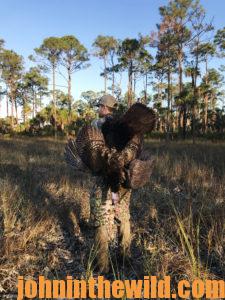 Another question I’m asked is, “Whose diaphragm calls do you use for turkey hunting and competition calling?” I build my own, because I like to build calls that will consistently be the same, and I like to tinker with different types of materials and various amounts of stretching the diaphragms. When I’m going hunting, I’ll usually have four or five different diaphragm calls in my turkey vest. The pot call I use is built by Jimmy Schaffer of Oak Ridge Custom Calls (http://www.oakridgecustomcalls.com/), and I also have a Pollard’s Elite crystal pot call (http://www.pollardselitecalls.com/) that a friend of mine gave me. I’ll usually have a slate-surfaced pot made by Lonnie Mabry too.
Another question I’m asked is, “Whose diaphragm calls do you use for turkey hunting and competition calling?” I build my own, because I like to build calls that will consistently be the same, and I like to tinker with different types of materials and various amounts of stretching the diaphragms. When I’m going hunting, I’ll usually have four or five different diaphragm calls in my turkey vest. The pot call I use is built by Jimmy Schaffer of Oak Ridge Custom Calls (http://www.oakridgecustomcalls.com/), and I also have a Pollard’s Elite crystal pot call (http://www.pollardselitecalls.com/) that a friend of mine gave me. I’ll usually have a slate-surfaced pot made by Lonnie Mabry too.
Since last turkey season, I’ve started wearing some more-aggressive hiking boots made by a company called Crispi (https://www.crispius.com/). I shoot a Franchi Affinity 3-inch 20 gauge shotgun (https://www.franchiusa.com/affinity-3-compact-shotgun). I can put that 20 gauge on my back and not even know I’m carrying a shotgun until I need it. I use a Trulock choke
(https://trulockchokes.com/turkey_hunting/). This gun will harvest a bird farther than anyone really needs to shoot a turkey, but I draw the line at 40 yards. I hand-load my shells and use Tungsten Super Shot (TSS) (https://www.tungstensupershots.com/). Federal Premium Ammunition (https://www.federalpremium.com/) and Apex Ammunition (https://apexmunition.com/) are making it now. I like carrying a gun that weighs less than 6 pounds, but I don’t want to sacrifice the ability to harvest a turkey quickly and efficiently. I know with that 20 gauge shotgun, I can have a very-effective pattern and plenty of knock-down power, and I can hit the bird harder and better with the reloaded shells than any commercially-loaded 20 gauge shell.
When I’m hunting, my binoculars are invaluable. I use Vanguard Endeavor 10×42
(https://www.vanguardworld.com/products/endeavor-ed-1042) that have great light-gathering ability and really perform well for me. I’ll have them around my neck, regardless of the type of terrain where I’m hunting. I’m really rough on binoculars. I’ve crawled with them under me, and I’ve knocked the eye cups off them, but these binoculars have been phenomenal binoculars.
I know that some people may not approve of crawling on turkeys, especially on public lands. But many times, I’ve found that getting that extra 5-10 yards closer to the turkey I’m trying to take is often the difference in taking him or not taking him. Your odds are greater for taking that turkey if he has less distance to travel to get to you. So, I do what I have to do to get close to a gobbler I’m trying to take. That’s just the way I do things.
I’m often asked, “Do you use decoys and blinds?” My standard answer is as far as I’m concerned, those are for kids. Those hunting aids change the nature of the game of turkey hunting for me, and I don’t like the way that the blinds and the decoys change the way I like to turkey hunt. Don’t get me wrong, I have used them, but I see them as a crutch. If someone else wants to use them, that’s fine with me. They’re just not fine for me. I’m not against anybody using anything that’s legal to turkey hunt with, but blinds and decoys are just not the way I like to turkey hunt. When I’ve taken a turkey using a blind and decoys, it just didn’t feel right to me. So, I’ve just decided not to use them.
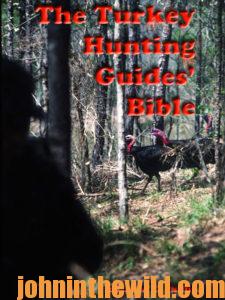 To learn more about turkey hunting, check out John E. Phillips’s book, “The Turkey Hunting Guides’ Bible,” at https://www.amazon.com/gp/product/B01ITWYY2K/ref=dbs_a_def_rwt_hsch_vapi_taft_p2_i11 and available in Kindle, print and Audible versions. You may have to cut and paste this link into your browser. (When you click on this book, notice on the left where Amazon says you can read 10% of the books for free and hear 10% for free). To learn more about other turkey books by John E. Phillips, go to www.amazon.com/author/johnephillips.
To learn more about turkey hunting, check out John E. Phillips’s book, “The Turkey Hunting Guides’ Bible,” at https://www.amazon.com/gp/product/B01ITWYY2K/ref=dbs_a_def_rwt_hsch_vapi_taft_p2_i11 and available in Kindle, print and Audible versions. You may have to cut and paste this link into your browser. (When you click on this book, notice on the left where Amazon says you can read 10% of the books for free and hear 10% for free). To learn more about other turkey books by John E. Phillips, go to www.amazon.com/author/johnephillips.

